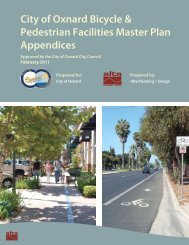View File - Development Services - City of Oxnard
View File - Development Services - City of Oxnard
View File - Development Services - City of Oxnard
Create successful ePaper yourself
Turn your PDF publications into a flip-book with our unique Google optimized e-Paper software.
WATER RESOURCES TECHNICAL REPORT• Property availability for expansion and construction <strong>of</strong> Phase 2 facilities• Groundwater basin water levels in response to future climatic conditions (e.g., extendedwet or dry periods)• Evolving regulations, specifically with respect to Department <strong>of</strong> Health and Safetyregulations which may affect well location, spacing, and operation• Location <strong>of</strong> future private water supply wells• Feasibility <strong>of</strong> recycled water injection (e.g., clogging and/or geotechnical issues)• Mixing properties <strong>of</strong> recycled water and groundwater when recycled water is injectedinto aquiferDetailed design for a large portion <strong>of</strong> Phase 2 components is dependent upon the results <strong>of</strong>implementing Phase 1. Therefore, Phase 2 facilities are described in less specific detail thanPhase 1.4.4.1 Tertiary Treatment Facility ExpansionThe TTF would be expanded from 5 mgd to a capacity <strong>of</strong> up to 32.6 mgd. This wouldrequire the addition <strong>of</strong> two additional secondary effluent pumps, three strainers, eightmicr<strong>of</strong>iltration (MF) or ultrafiltration (UF) units, and a second 600,000-gallon tertiaryeffluent storage tank.4.4.2 Advanced Water Treatment Facility ExpansionThe AWTF would be expanded from 3.8 mgd to a capacity <strong>of</strong> up to 15.3 mgd for treatment<strong>of</strong> and blending with tertiary treated water for agricultural irrigation, distribution <strong>of</strong>permeate to industrial users, and delivery <strong>of</strong> recycled water to ASR wells. If BlendingOption 1 is implemented in Phase 1, potable water from the <strong>Oxnard</strong>-Hueneme Pipeline maybe added after advanced treatment for the purposes <strong>of</strong> blending. With the addition <strong>of</strong>potable water for blending, a total <strong>of</strong> up to 24 mgd could be available for distribution.Expansion <strong>of</strong> the treatment capacity <strong>of</strong> the AWTF will require a larger capacity recycledwater booster pump station (24 mgd) to pump treated water to irrigation users and/or theASR well locations. The pump station would be contained within the pump station buildingconstructed under Phase 1. In addition, a second 300,000-gallon storage tank would beconstructed to store the additional permeate produced by expansion <strong>of</strong> the treatmentfacility. This would increase onsite permeate storage capacity from approximately300,000 gallons to approximately 600,000 gallons.4.4.3 Recycled Water Delivery System ExpansionRecycled Water Conveyance for Agricultural IrrigationThe recycled water delivery system would be expanded from 3.4 mgd to a capacity <strong>of</strong>24 mgd. Irrigation quality recycled water would continue to be generally distributed to thePleasant Valley area approximately 9 months each year; however, it is anticipated thatdelivery <strong>of</strong> recycled water would be expanded to connect to additional existing irrigationdelivery systems. Under Phase 2, the Recycled Water Delivery System would connect to theW112003002SCO LW1458.DOC/ 033390002 61
















